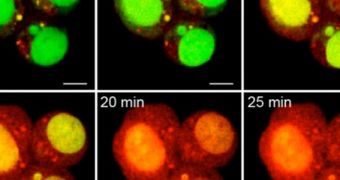A group of investigators at the Massachusetts Institute of Technology (MIT) in Cambridge announces the development of a new type of nanoparticles that can carry three or more chemotherapy drugs at the same time. Previous generations of nanoparticles could only carry one or two drugs, which limited their ability to effectively interfere with the development of cancer tumors.
These minute particles are currently the focus of numerous studies, since they enable oncologists to precisely target tumors without causing negative side-effects to healthy tissues nearby. This is one of the main problems associated with conventional chemotherapy, the fact that it acts indiscriminately on both diseased and healthy tissues.
Nanoparticles can be steered to affect only designated targets through a variety of methods, either by magnetic fields, by tracker proteins on their surfaces, or by other methods. This makes them invaluable tools in our fight against cancer, but they too have their limitations. The MIT team was recently able to remove one of the most significant limitations, paving the way for new treatments against cancer.
Usually, the tiny synthetic particles carry drugs either on their surface or encapsulated inside. This means that scientists are able to bind two different drug molecules to the same particle, which made for more effective treatments. The MIT group has developed nanoparticles made out of building blocks that already include drugs, a feature that enables the precise control of drug ratios inside the system.
“If I want a particle with five drugs, I just take the five building blocks I want and have those assemble into a particle. In principle, there’s no limitation on how many drugs you can add, and the ratio of drugs carried by the particles just depends on how they are mixed together in the beginning,” explains MIT assistant professor of chemistry Jeremiah Johnson, a member of the research group.
The various blocks used to assemble the new type of nanoparticles each feature a so-called linking unit, which is basically a tool for connecting it to all other blocks. Additionally, the blocks are coated with polyethylene glycol (PEG), a material meant to protect the nanoparticles as they travel through the rough environment that is the human circulatory system.
In the new study, the MIT science group was able to synthesize nanoparticles that carried the chemotherapy drugs isplatin, doxorubicin, and camptothecin. Oncologists use one, two, or all three of these drugs in combination to address ovarian cancer. The particles proved to be more effective at killing cancer cells than previous versions carrying just one or two of these compounds.
Details of the investigation were published in the April 11 issue of the esteemed Journal of the American Chemical Society (JACS). MIT postdoctoral researcher Longyan Liao was the lead author on the new paper. The team will from now on focus on testing the new nanoparticles on animal models, and on developing delivery systems capable of carrying four drugs simultaneously, IEEE Spectrum reports.

 14 DAY TRIAL //
14 DAY TRIAL //